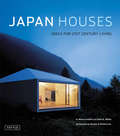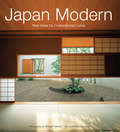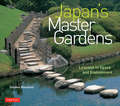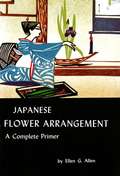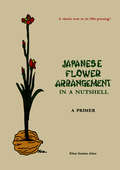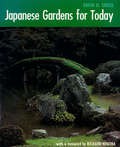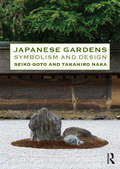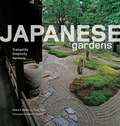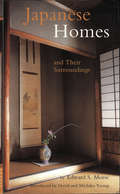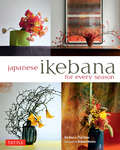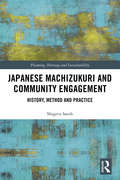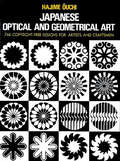- Table View
- List View
Jamestown Furniture Industry, The: History in Wood, 1816-1920
by Clarence CarlsonWhile all but gone today, Jamestown's furniture industry was once the second-largest producer of furniture in the United States. Manufacturing boomed from 1816, when William Breed and Royal Keyes opened their shops, to the 1920s, when Jamestown was still one of the top wood furniture producers in the country. In the nineteenth century, the thriving railroad industry allowed Jamestown's quality creations to be distributed nationwide. After the Civil War, an influx of Swedish immigrants brought their craftsmanship and skills to Jamestown, forming Morgan Manufacturing, Empire Furniture Company and many others. Then, their pieces were valued for quality and durability; today, they're coveted by collectors as beautiful antiques. Local expert Clarence Carlson uncovers the fascinating story of Jamestown furniture.
Jamie Durie's Edible Garden Design: Delicious Designs from the Ground Up
by Jamie DurieColorful and practical, an edible garden can radically transform an outdoor space and is an affordable, sustainable source of fresh fruit, vegetables, and herbs. In this hands-on guidebook, internationally renowned home and garden design expert Jamie Durie reveals how to plant, arrange, and maintain an edible garden that works in all climates and in spaces of all shapes and sizes.
Jamie Durie's The Outdoor Room
by Jamie DurieJamie Durie, international award-winning horticulturalist and landscape designer, reveals the secrets behind his incredible designs on the ever-popular HGTV series The Outdoor Room, now viewed in over twelve countries. With dynamic photography, including Jamie's personal travel photographs and a sneak peek of his private garden, this information-packed companion to his smash-hit t.v. show is as hardworking as it is stunning. Complete with detailed site plans, zonal plant lists, and helpful eco-tips, it covers everything from the basics of landscape design to practical, hands-on information, such as how to design your own private garden using Jamie's philosophy. From an exotic Balinese-inspired dining pavilion to a private English-style garden with an adjoining children's play area, Jamie shows you how to incorporate his techniques and design principles to create a personal and truly unique garden, giving you and your family and friends the opportunity to reconnect with nature in the privacy of your very own outdoor room.
Japan Country Living
by Amy Slyvester Katoh Shin KimuraFrom Japanese antiques to home and garden design, Japan Country Living is a delightful introduction for art and furniture lovers. In over 400 full-color photographs of quaint country homes, lush gardens, simple decorations and traditional dishes and recipes, the lifestyle of the Japanese countryside as it was yesterday can be found in this book. This book lets readers visit charming Japanese country homes and gardens and discover a lifestyle that has been handed down for centuries.
Japan Country Living
by Amy Slyvester Katoh Shin KimuraFrom Japanese antiques to home and garden design, Japan Country Living is a delightful introduction for art and furniture lovers. In over 400 full-color photographs of quaint country homes, lush gardens, simple decorations and traditional dishes and recipes, the lifestyle of the Japanese countryside as it was yesterday can be found in this book. This book lets readers visit charming Japanese country homes and gardens and discover a lifestyle that has been handed down for centuries.
Japan Home: Inspirational Design Ideas
by Noboru Murata Lisa Parramore Chadine Flood GongWhether you're remodeling your house, redesigning your apartment or just looking for a book of design ideas, Japan Home is a beautiful and indispensable resource full of practical information, shopping resources and inspiration.<P><P>Japanese interior design has long been renowned for its spare beauty, utility and grace. Today, more and more people outside Japan are incorporating Japanese features in their homes and gardens as they come to appreciate the way in which materials, colors, patterns and shapes are interwoven in a uniquely light and evocative way.Japan Home, lavishly illustrated with full-color photos and packed with practical information, is the perfect source for anyone eager to find ways to decorate or enhance their home with that special Japanese flair. The authors explore ways to create typical Japanese spaces both inside and outside the home that are tranquil yet dramatic, understated yet elegant. All designs are enriched with the distinct Japanese aesthetic.
Japan Houses: Ideas for the 21st Century
by Geeta K. Mehta Marcia Iwatate Takeshi NakasaThis Japanese architecture and design book is a wonderful source of new styles and ideas for those looking to add a distinctively Zen flair to their home.<P><P>Limited spaces, unlimited technology, a tradition of innovation, and sheer Japanese panache have combined to inspire the 26 stunning homes featured in Japan Houses. Conceived by 24 of Japan's leading architects and designers, each of the houses forecasts and defines a new trend in residential architecture, reinventing the meaning and use of space, material, and function.Traditional lifestyles are challenged, domestic functions such as cooking and entertaining are moved out of the house into the public domain, while laptops bring work back in. Zen minimalist is juxtaposed with comfortable opulence, time-honored workmanship is coupled with exciting new materials, resulting in a recognizable style that belongs to Japan, reflecting its culture and craftsmanship, while at the same time being avant-garde and international. The spirit of each of these astonishing houses is captured in beautiful photographs, plans and commentary.
Japan Modern: New Ideas for Contemporary Living
by Michael Freeman Michiko Rico NoseFeaturing over 200 stunning photographs, this Japanese design book captures the delightful, modern style of the Japanese home.Japan has always intrigued the world with its deceptively simple blending of architecture, landscape and design. <P><P>Zen temples, the famous tea ceremony, formal gardens, the use of wood, paper and other materials in the form of screens and floors--all have evolved over the years to create a varied, yet indisputably unique style. Japan Style showcases 40 contemporary homes, many never photographed before, and explores the unique Japanese design in all its manifestations. The book is divided into four chapters-- Reworking Tradition Managing Space Experimenting with Materials Personal Statements Each home is representative in its own way of the changing face of Japanese interior design and architecture and will be sure to inspire some new design ideas for your own home.
Japan the Art of Living
by Amy Slyvester Katoh Shin KimuraIn more than 300 beautiful photographs of the homes of both Westerners and Japanese, this book presents the art of living with Japanese style, offering exciting new ideas and inspiration for all. Exquisite homes in the Tokyo area, focusing on original and attractive use of Japanese antiques and folk crafts, are showcased. Also included is the latest information on antique markets and hints for where to see the art of living - in galleries, textile and craft shops, and resaurants.
Japan's Master Gardens
by Stephen MansfieldNo two Japanese gardens are ever the same. Each is inimitable, yet embodies commonalities of design and aesthetic taste. Each finds the space for innovation within a tradition that benefits from a thousand years of applied knowledge. Presenting twenty-five master gardens, Japan's Master Gardens explores the ingenuity and range of Japanese landscaping, from the self-imposed confines of courtyard designs to the open expanses of the stroll garden.Japan's Master Gardens illustrates how, through the ministrations of generations of gardeners, original landscapes have maintained their mastery and demonstrates how contemporary landscaping draws from tradition, making ancient gardens relevant to the lives of people in the twenty-first century.This beautifully illustrated book takes readers on an exploration of the outward forms, underpinning principles, complex use of metaphor and allusion, and beauty and depth that set the Japanese garden apart.
Japan's Master Gardens
by Stephen MansfieldNo two Japanese gardens are ever the same. Each is inimitable, yet embodies commonalities of design and aesthetic taste. Each finds the space for innovation within a tradition that benefits from a thousand years of applied knowledge. Presenting twenty-five master gardens, Japan's Master Gardens explores the ingenuity and range of Japanese landscaping, from the self-imposed confines of courtyard designs to the open expanses of the stroll garden.Japan's Master Gardens illustrates how, through the ministrations of generations of gardeners, original landscapes have maintained their mastery and demonstrates how contemporary landscaping draws from tradition, making ancient gardens relevant to the lives of people in the twenty-first century.This beautifully illustrated book takes readers on an exploration of the outward forms, underpinning principles, complex use of metaphor and allusion, and beauty and depth that set the Japanese garden apart.
Japanese Design Motifs: 4,260 Illustrations of Japanese Crests (Dover Pictorial Archive)
by Matsuya CompanyThis collection presents more than 4,000 individual designs in the 900-year-old tradition of Japanese family crests. Through constant variation and invention over the centuries, this has become one of the richest graphic art traditions in the world.Most of these motifs are circular, and they can all be fitted into a square. Within those limitations is a seemingly endless range of designs, beginning with the dozens and dozens of root motifs — rice plant, gingko, scallop, lightning, anchor, spool, raft, candle, scissors, fern, saki bottle, lotus blossom, mountain arrow, pine, wisteria, ship, rabbit, and scores of others. Practically every kind of plant, bird, animal, natural phenomenon, and manufactured object of Japanese culture was at one time or another included in a family crest. In addition, each of the root designs was treated to dozens of imaginative variations — they were reproduced bilaterally, in triangles, diamonds, five- and six-pointed stars, in spirals, were built up in series, made to overlap, combined with each other, and so on. Some of these are classic and recognizable designs, like the yin-yang, linked rings, and treasure knot. Many of the others have rarely been seen in the West.Graphic artists, textile designers, pattern-makers, advertisers, and other commercial artists looking for an untapped source of novel, appealing designs will find a wealth of material here. Some of these motifs can be used to suggest an exotic flavor, and others are universal and can be used almost anywhere.
Japanese Flower Arrangement: A Complete Primer
by Ellen G. AllenThere is something of the artist in each of us. Some of us find expression in painting, poetry, or sculpture, some in landscape gardening. With talent and facility, expression in these art forms is Satisfying. <P><P>And this is true also of flower arranging, an ancient art that can express a thought or mood and in a sense combine the expression of severnl other media. Yet special talent for flower arranging is not essential. The 'feeling' for it is engendered by the practice of it!' With these words Ellen Gordon Allen begins the introduction to her eminently practical primer of Japanese flower arrangement, which is here being offered in a new revised edition. As a certified teacher (Oharn school)and a very successful one, Mrs. Allen is well qualified to present her subject.The purpose of her book is fourfold: to increase the skill of all who love to arrange flowers to provide a more comprehensive understanding of the Japanese art of flower arrangement; to help students when no teacher is available; andto provide a medium of instruction among the many, often confusing, schools of Japoncse flower arrangement. It is Mrs. Allen's hope that the primer will serve as a practical handbook for beginners and that it will dispel the aura ofmystery that seems to surround the subject. To this end, she has made her instructions as elementary as possible. The few fundamental rules of Japanese flower arrangement and the various techniques are presented in a simple manner.Wherever possible, English equivalents have been substituted for Japanese terms. Each lesson sketches, photographs, and diagrams which clearly show the student what to do in working toward completion of the arrangement. Although Mrs. Allen teaches principally the methods of the Ohara school for the moribana and heika styles and the methods of the Saga school for the seika style, her book is also a compilation of information from the Sogetsu, the Ikenobo, the Sho-fu·ryu, and other famous schools in Japan. She has selected what she considers most practical for use in the American or other foreign setting. By using the slep-by-step methods outlined in the 14 well-organized lessons, the Rowerarrangementstudent will not only be able to learn rapidly but will also experience the pleasure of making genuine progress in an art that provides an endless source of enjoyment. And, as Mrs. A1len expresses it, "it is the enjoyment of making flower arrangements that I want particularly to stress. Learn the fundamentalsand you will enjoy their application, sharing your pleasure with others who will marvel at your skill in arranging flowers."
Japanese Flower Arrangement: A Primer
by Ellen Gordon AllenThis Japanese gardening book is a practical, concise guide to flower arranging or Ikebana.Illustrated with dozens of helpful photographs and diagrams, this flower arranging handbook provides full and comprehensive treatment of the various forms of Moribana and Heiki style arrangements. <P><P>Each lesson is given in detail step by step with accompanying sketches, showing clearly what should be done as the arrangement progresses towards completion. The photographs of actual completed flower arrangements sum up beautifully the principles underlying each particular style.The purpose of this text is to acquaint the reader with elementary knowledge in a special school of flower arranging-the Japanese school-selected because it is the oldest and its teachings are perhaps the simplest, yet most effective. The text is intended for amateurs, but professional arrangers might find it useful as a refresher.
Japanese Garden Design
by Marc P. Keane Haruzo OhashiThe creation of a Japanese garden combines respect for nature with adherence to simple principles of aesthetics and structure. In Japanese Garden Design, landscape architect Marc Peter Keane presents the history and development of the classical metaphors that underlie all Japanese gardens.Keane describes the influences of Confucian, Shinto and Buddhist principles that have linked poetry and philosophy to the tangible metaphor of the garden. Detailed explanations of basic design concepts identify and interpret the symbolism of various garden forms and demonstrate these principles in use today.
Japanese Garden Design
by Marc P. Keane Haruzo OhashiThe creation of a Japanese garden combines respect for nature with adherence to simple principles of aesthetics and structure. In Japanese Garden Design, landscape architect Marc Peter Keane presents the history and development of the classical metaphors that underlie all Japanese gardens.Keane describes the influences of Confucian, Shinto and Buddhist principles that have linked poetry and philosophy to the tangible metaphor of the garden. Detailed explanations of basic design concepts identify and interpret the symbolism of various garden forms and demonstrate these principles in use today.
Japanese Gardens for Today
by David EngelWith extensive photographs and diagrams, this book explains the philosophy and practice of Japanese gardening.<P><P>An important classic of gardening instruction, Japanese Gardens for Today is a practical down-to-earth explanation of the basic rules of Japanese garden design and care. It is sure to prove of great value to both the professional landscape architect and to the green-thumbed home owner, whether he is designing an entirely new garden or only seeking an illusion of spaciousness and rightness in a tiny courtyard or corner.Photographs of historic Japanese gardens and the private, modern gardens of Japanese homes are given alongside useful rule-of-thumb practices and techniques. The books wealth of drawings are fully integrated with clear, succinct text to present the first full and practical treatment of the subject ever published in English.
Japanese Gardens: Symbolism and Design (Asian Thought And Culture Ser. #56)
by Seiko Goto Takahiro NakaThe unique beauty of the Japanese garden stems from its spirituality and rich symbolism, yet most discussions on this kind of garden rarely provide more than a superficial overview. This book takes a thorough look at the process of designing a Japanese garden, placing it in a historical and philosophical context. Goto and Naka, both academic experts in Japanese garden history and design, explore: The themes and usage of the Japanese garden Common garden types such as tea and Zen gardens Key maintenance techniques and issues. Featuring beautiful, full-colour images and a glossary of essential Japanese terms, this book will dramatically transform your understanding of the Japanese garden as a cultural treasure.
Japanese Gardens: Tranquility, Simplicity, Harmony
by Geeta K. Mehta Noboru Murata Kimie TadaFeaturing beautiful photographs and insightful commentary this Japanese gardening book is a must have for any gardening or zen enthusiast.At the heart of a Japanese garden is harmony with nature. <P><P>More than simply a landscape of trees and flowering shrubs, a Japanese garden provides a place of serenity and rest, filled with peaceful spots that lend themselves to meditation and contemplation. Japanese Gardens celebrates and illustrates this ideal, showcasing the exquisite natural beauty of more than 20 quintessentially Japanese gardens--big and small, urban and rural, traditional and contemporary.The expert author-and-photographer team behind this book excels at capturing and explaining the essential elements and techniques that distinguish Japanese garden design from that of other countries. The featured sites reflect a cross section of Japanese culture and history including large feudal period gardens, temple and Zen gardens and private countryside gardens. The mountain flower garden, tea garden, rock garden and bonsai garden alike are all celebrated and appreciated in this beautiful book.
Japanese Gardens: a journey
by Monty Don Derry MooreSHORTLISTED FOR THE EDWARD STANFORD PHOTOGRAPHY TRAVEL BOOK OF THE YEAR 'A fabulous, bonsai-filled book' Daily MailThe complement to the BBC2 series, Japanese Gardens: written by the nation's favourite gardener Monty Don, and beautifully produced with over 200 original photographs from Derry Moore. Traditional Japanese gardens combine aesthetics with ethics in a perfectly curated celebration of nature. A Japanese garden is the natural world made miniature: rocks represent mountains, ponds represent seas. In this personal and lyrical exploration of both the traditional and the modern aspects of Japanese gardening, Monty Don takes a look at the traditions and culture which inform some of the most beautiful gardens from all over Japan, from Kenroku-en to the Zen gardens of Tokyo and the historic beauty of Kyoto.Monty Don and Derry Moore guide us through the history and spectacular seasons of Japanese gardens, from the famous cherry blossom celebration hanami to the autumnal crimson magnificence of momijigari. Monty Don also explores the creative forms uniquely associated with Japanese gardens, from stone-masonry and ikebana to the intricate skill of bonsai. Stunningly photographed by Derry Moore, Japanese Gardens is a fascinating exploration of a unique relationship with gardens.'An illuminating insight not only into the history and horticulture of some remarkable gardens but also into the Japanese culture and psyche' Gardens IllustratedALSO BY MONTY DON & DERRY MOOREPARADISE GARDENS: THE WORLD'S MOST BEAUTIFUL ISLAMIC GARDENSAs seen on the highly acclaimed BBC2 series, a glorious celebration of the richness of Islamic culture through some of the most beautiful gardens on earth.'Sun-filled escapism' Country Life 'Simply breathtaking' Love it!
Japanese Gardens: a journey
by Monty Don Derry MooreThe complement to the BBC2 series, Japanese Gardens: beautifully produced with over 200 original photographs by Derry Moore and written by Monty Don, the duo behind the highly-acclaimed Paradise Gardens.Traditional Japanese gardens combine aesthetics with ethics, beauty with philosophy in a perfectly curated celebration of the natural world. A Japanese garden is the natural world made miniature: rocks represent mountains, ponds represent seas. Natural and man-made elements combine to create a garden that, while natural, is not wild.In this personal and lyrical exploration of both the traditional and the modern aspects of Japanese gardening, Monty Don takes a look at at the traditions and culture which inform some of the most beautiful and famous gardens from all over Japan, from Kenroku-en to the Zen gardens of Tokyo and the historic beauty of Kyoto.Monty Don and Derry Moore travelled to Japan in spring and autumn, and this book guides us through the history and beauty of Japanese gardens in these spectacular seasons - from the famous cherry blossom celebration hanami to the autumnal crimson magnificence of momijigari. Monty Don also explores the creative forms uniquely associated with Japanese gardens, from stonemasonry and ikebana to the intricate skill of bonsai. Stunningly photographed by Derry Moore, Japanese Gardens is a fascinating exploration of a unique relationship with gardens.PRAISE FOR PARADISE GARDENS'Sun-filled escapism' Country Life 'Simply breathtaking' Love it!
Japanese Homes and Their Surroundings
by Edward MorseA classic text, Japanese Homes and Their Surroundings was originally published in 1886 by Edward S. Morse, a groundbreaking and imaginative inventor. Still considered an authoritative review of traditional Japanese architecture and landscape design, Japanese Homes and Their Surroundings contains over 300 detailed illustrations and reveals important historical and cultural sources, making it a time-tested resource for architects and landscape designers.
Japanese Ikebana for Every Season
by Noboru Murata Yuji Ueno Rie ImaiThe true meaning of Ikebana-the traditional Japanese art of flower arrangement-is the ability to take a few beautiful flowers and plans and tastefully present them in very simple containers to decorate your home. Whether for Mother's Day, Valentine's Day, or a special birthday or anniversary-Japanese Ikebana for Every Season simplifies and demystifies this ancient art by presenting 53 elegantly simple arrangements that anyone can create at anytime at home.The key to good Ikebana arrangements is to understand a few very simple principles-like the idea of mitate-seeing old things with new eyes, as well as learning a few very easy techniques of flower stabilization and how to support plants and flowers inside a vase or container. Using simple, common flowers and plants from your garden, from a nearby field or forest, or from your local florist-you can easily create these lovely Ikebana in just a few minutes if you know how.Authors Rie Imai and Yuji Ueno explain how to select the flowers and the containers by simply using things that are already around you-and then they show you how to turn them into something special. The basic instructions in the book cover a wide range of styles that encourage readers to use their own creativity rather than copying traditional and highly technical Ikebana design concepts.No matter what time of year it is and regardless of your taste or budget-the arrangements in this book will lend a touch of Japanese elegance to your home!
Japanese Machizukuri and Community Engagement: History, Method and Practice (Planning, Heritage and Sustainability)
by Shigeru SatohOver the past few decades, Japan has faced severe earthquake disasters, an increasing aging population, declining birth rates, and widening social disparities. These issues have served to highlight gaps left by top-down governance approaches and the urgent need to create resilient societies using more traditional models. Japanese “machizukuri” has developed to become an exceptional example of bottom-up creative approaches based on collective action and use of local resources. Since its evolution in the 1960s, machizukuri has come to define diverse and creative community-driven management models, by which local communities are enabled to actively tackle problem-solving. Including contributions from experts directly engaged in the process, this book explores the original development of machizukuri in Japan, its diffusion through East Asia and the positive outcomes of this transfer. Combining theoretical explanations with practical case studies, from pre-disaster planning in Tokyo, to the revitalization of historic towns and rural areas around Japan, the book looks at specific solutions, tools, and links between academics, communities, organizations, governmental bodies, and the private sector. It will appeal to researchers in planning, community engagement, architecture, urban design, and sustainable development.
Japanese Optical and Geometrical Art (Dover Pictorial Archive)
by Hajime OuchiSome of the most ingenious and attractive modern motifs. 746 designs.





